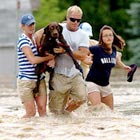大地震预报与预测的区别
附:伯兰彼德博士解释说明的原文:
From: Michael Blanpied
USGS Earthquake Hazards Program, Reston, Virginia, USA
Date: Sat, 24 May 2008 11:42:58 -0400.
Paul Spudich and I have discussed your correspondence about earthquake prediction, which i
s a very interesting subject and an important one to many Chinese at this moment.
Responding to your first question: "If the above statement is true, then please explain the following rumors (successful earthquake forecasts with certain time and place) made by The Chinese State Seismological Bureau (including its local offices):" [*]
Most American seismologists agree that the 1975 Haicheng earthquake was successfully predicted. A team of Canadian and Chinese scientists examined the events preceding the Haicheng earthquake and agreed with this assessment. Their study is published in an American seismological journal at:
and summarized in plain-English form in the magazine GeoTimes at:
Most American seismologists also agree that the Haicheng earthquake is the -only- successful prediction of a large earthquake. Despite decades of work and many attempts, using many methods, no other large earthquakes have been successfully predicted in the short term.
Unlike most earthquakes, the Haicheng earthquake was preceded by hundreds of small foreshocks that made the prediction easier. Only a few big earthquakes have foreshocks, and it is extremely rare to have a strong sequence of foreshocks. Usually a foreshock cannot be distinguished from any of the other thousands of small earthquakes that happen every day.
Unfortunately we have no information on the predictions of the other earthquakes that you listed, so cannot comment on them.
You also asked: "If the statement is true, then the fact becomes: The USGS does not make earthquake predictions, but conducts forecasting, such as 50/30/10-years/probability-10% forecast and 24-hours forecasting nationwide. Correct or false?"
You make a good point. In the U.S. the term 'prediction' usually means a statement that an earthquake having a specified magnitude will occur in a short time interval (a day to a year), and in a well defined region (a city, county, or part of a U.S. state), and with a high probability much higher than the usual, day-to-day probability. The only U.S. prediction that has ever been endorsed by the USGS was that of the Parkfield earthquake; in that case a magnitude-6 earthquake was predicted to occur on a specific part of the San Andreas fault between 1985 and 1993. The earthquake occurred, but not until 2004.
The U.S. public really wants us to predict earthquakes, and unfortunately most American seismologists (and the USGS) agree that we seismologists do not know how to make predictions with accuracies like the above definition. We are good at predicting the locations, magnitudes and shaking of future earthquakes, but we have no way to predict the time.
The USGS uses the term 'forecast' to mean a statement that an earthquake (or ground shaking) will occur in a specific place sometime during a longer time interval (5 - 50 years), usually at a much lower probability level. We cannot evacuate cites based on these forecasts because of the long time interval, but the public can use these forecasts to prepare their homes, offices, and factories for the future shaking. Such forecasts form the basis for improved building codes, insurance rates, city planning, and response planning.
Note that seismologists usually use the word 'earthquake' to mean slip on a fault (also called fault rupture); the public uses 'earthquake' to mean ground shaking. The USGS forecasts both of these. Here are examples:
So, for an example of a shaking forecast, see: <http://www.earthquake.usgs.gov/research/hazmaps/products_data/1996/hazmaps/CAmap1r.gif>
This is a map of California and Nevada that forecasts the strength of shaking (specifically the peak ground acceleration in % of g, the acceleration of gravity) that has a 90% chance of not being exceeded in 50 years. So, if you look at the intersection of the California, Nevada, and Oregon borders (at 42.0 degrees north, 120.0 degrees west), you will see that the map is yellow-green, which indicates that at that location there is a 90% probability that the ground motion will not exceed about 14% g (or a 10% probability that the shaking will exceed 14% g) sometime in the next 50 years.
For an example of a forecast of slip (rupture) on faults, see:
The colors on this California map represent the probabilities of having nearby (within about 6 km) fault slip during an earthquake of magnitude 6.7 or larger in the next 30 years. So the blue of Sacramento means that there is a 0.01% chance in the next 30 years that an earthquake fault within 6 km of Sacramento will slip in a magnitude 6.7 (or larger) earthquake.
There is one time when we can say more specific things about the timing of earthquakes, and that is during aftershock sequences. We know very well that a large earthquake will generate many aftershocks, that the aftershock rate will generally decrease with time, and that there will generally be more smaller aftershocks and fewer large ones. We cannot predict the time or place of individual aftershocks, and we cannot predict how large the largest ones will be. For the state of California we publish a web map showing the probability of shaking from aftershocks and regular earthquakes in the next 24 hours:
The documentation is excellent, but I can briefly summarize here: The blue background shows the probability of a large earthquake in any 24 hours; this probability comes from observations of faults and past earthquakes and does not change. The yellow spots are areas of higher probability due to aftershocks of previous earthquakes; those spots typically fade away over a few days.
Note that the 24-hour map cannot predict the time or place of a large earthquake, and the map does not use any observations other than small earthquakes. At this time we do not know of any method for predicting the time and place of an earthquake. #
[*] The list of successful earthquake predictions (declared by CEA offices):
- 02-04-1975, Haicheng, Liaoning; M=7.3.
- 05-29-1976, 20:23, Longling county, Yunnan, M=7.3.
- 07-28-1976, 3:00 AM, Qinglong County, Hebei Province.
- 08-16-1976, Songpan-Pingjiang county, M=7.2.
- 05-21-1984, Huanghai, Jiangsu, M=6.2.
- 07-12-1995, morning, Menglian county, M=7.3.
|
编辑:
王平伟
|











